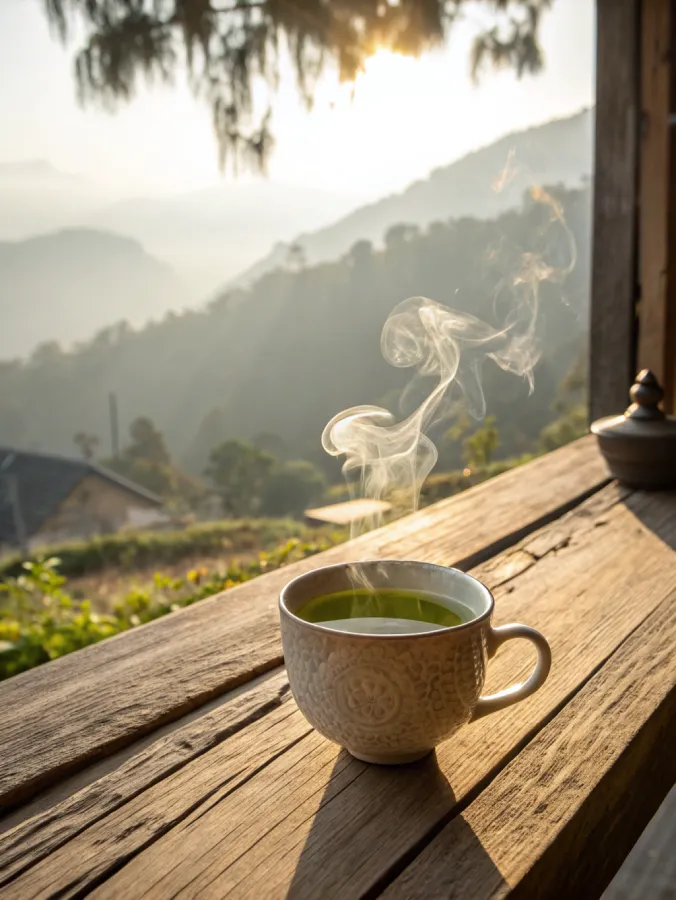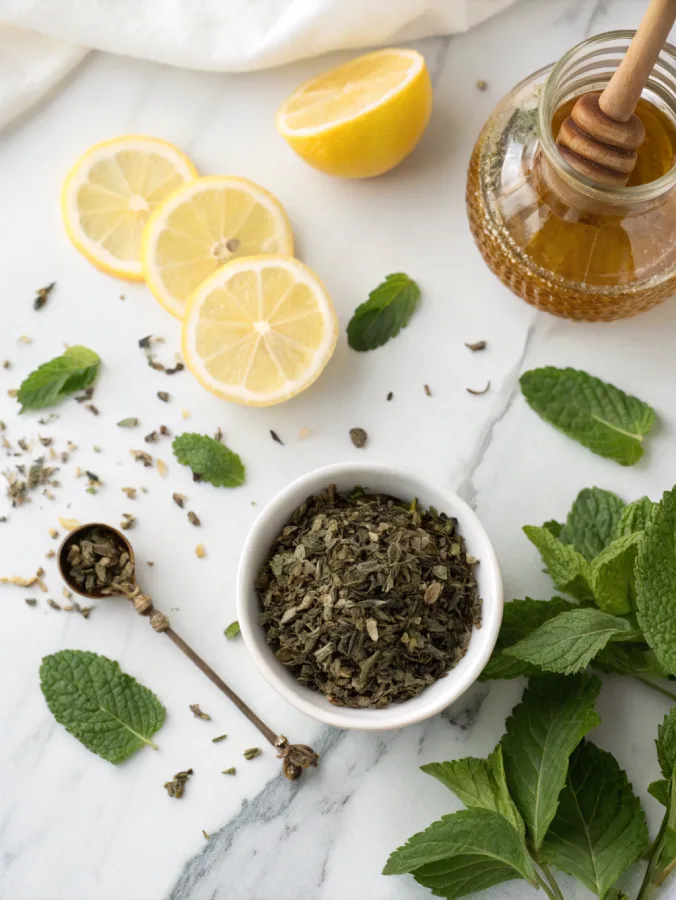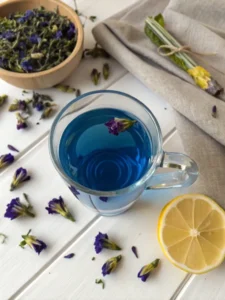
Green tea is more than a calming drink, it’s a powerhouse of natural antioxidants, gentle energy, and simple nourishment. From boosting metabolism to supporting brain health and weight loss, this ancient beverage has earned its place in modern wellness. Whether you’re brewing a hot cup or chilling it over ice, green tea fits effortlessly into daily routines. In this guide, we’ll explore its benefits, the best times to drink it, how to make it right, and why it might just become your new favorite ritual.
In this Article
Key Takeaways: What You Need To Know
- Green tea is loaded with antioxidants like EGCG.
- Supports metabolism, brain function, heart health, and fat burning.
- It’s easy to prepare hot or cold and pairs well with a healthy lifestyle.
- Includes moderate caffeine and can be enjoyed daily in balance.
- This guide covers health perks, weight loss tips, how to make it, caffeine info, and more.
Green Tea Benefits, Uses, and How To Make It – A Delicious Daily Ritual
Why Green Tea Became My Everyday Ritual
I still remember when green tea first became part of my routine. It was one of those foggy Asheville mornings, quiet, slow, and a little cold. I didn’t have coffee, but I did have a few stray tea bags in the pantry. One of them was green tea. I brewed it without much thought, but that first sip hit different. It wasn’t just warm, it was soothing. Clean. Centering.
Since then, green tea has become a morning essential. It gives me enough energy without the crash. It helps me focus, especially when paired with a refreshing drink like this apple cider vinegar, lemon, and honey tonic. And when I’m feeling under the weather, I reach for something like my honey lemon ginger tea to complement it.
What I love about green tea is its simplicity. No fancy ingredients. Just hot water and a few leaves, yet it packs in antioxidants, supports digestion, and even helps with those mid-day cravings that used to send me reaching for snacks. Once I added it into my daily rhythm, everything felt just a bit more grounded.
That’s what this article is about, real results from simple changes. I’ll walk you through green tea’s health benefits, how to use it for weight loss, when to drink it for the most impact, and how to make it hot or iced. Whether you’re brand new to green tea or already sipping daily, you’re in the right place.
The Science-Backed Benefits of Green Tea
Powerful Antioxidants in Every Sip
Green tea is rich in compounds called catechins, particularly one known as EGCG (epigallocatechin gallate). These antioxidants are well-documented for protecting your cells from free radical damage, which contributes to aging and chronic disease. Regular consumption may help lower oxidative stress and support overall cellular health.
Beyond just antioxidants, green tea offers a gentle lift in energy thanks to its natural caffeine content, without the harsh spike of coffee. It also contains L-theanine, an amino acid that promotes calm focus. This unique combo makes it one of the best choices for steady energy throughout the day.
What’s exciting is how green tea supports brain function. Studies suggest it may improve memory, alertness, and reaction time. In fact, long-term consumption has even been associated with a reduced risk of neurodegenerative disorders like Alzheimer’s and Parkinson’s.
I like pairing my green tea with something equally nourishing, like this lemon balm drink for weight loss when I need a calming reset or my hubert’s lemonade-inspired recipe for a zesty hydration boost in the afternoon.
Long-Term Health: Heart, Brain & Longevity
Beyond brain support, green tea shows promising benefits for heart health. Several large-scale reviews link it to lower LDL cholesterol, reduced blood pressure, and improved circulation. Drinking three to five cups per day may help lower your risk of heart disease and stroke over time.
There’s also some evidence that green tea drinkers may live longer. A Japanese study followed over 40,000 participants and found that those who drank the most green tea had a lower risk of all-cause mortality. That’s right, just a few cups a day may support longevity.
Its anti-inflammatory and fat-burning effects make it a useful ally if you’re managing blood sugar or simply trying to feel more balanced day to day. It’s not a magic fix, but when paired with a whole-food lifestyle, green tea supports the bigger picture of wellness.
Natural Support for Weight Management

Metabolism-Boosting Properties
One of the most researched aspects of this tea is its impact on metabolism. It contains compounds that may increase fat oxidation, especially when paired with light movement or moderate activity. Some studies even show a modest increase in calorie burning after consuming it regularly.
For people looking to support their metabolism without extreme diets, adding a few cups a day alongside a clean, nourishing meal can be a simple step. Pairing it with hydrating, low-sugar drinks like this Panera-style agave lemonade or nutrient-dense snacks helps round out the benefits.
While not a standalone solution, this plant-powered drink may work as part of a sustainable routine. In fact, some research has shown that regular consumption helps increase the body’s use of stored fat as fuel, particularly when combined with a protein-forward breakfast or a short walk.
Belly Fat and Appetite Regulation
Many wellness-minded folks turn to it when they’re trying to reduce stubborn abdominal fat. A 2022 review found that drinking several cups daily was linked to lower waist circumference, especially in women. Though results vary, there’s growing evidence that it may support changes in body composition over time.
What’s more, the drink may help regulate hunger. It contains compounds that subtly influence appetite hormones, making it easier to stick to smaller portions or avoid grazing between meals. Enjoy it before meals to help feel satisfied sooner, or pair it with a fiber-rich snack like this ron ron juice recipe for added fullness.
Like all wellness tools, it’s most effective when combined with smart habits, balanced meals, regular movement, and adequate hydration. Still, it’s one of the most accessible ways to support healthy change without overwhelming effort.
Finding the Right Time to Sip
Morning, Afternoon, or Evening?
Timing matters when it comes to maximizing the benefits of this drink. Sipping it in the morning can offer a clean boost of energy to start the day, thanks to its natural caffeine and calming L-theanine. It’s often a more balanced choice than coffee, which can spike cortisol and lead to an afternoon crash.
Drinking it after lunch may also help aid digestion and improve alertness during that common afternoon slump. Many find it helpful as a light pick-me-up without disturbing their sleep later on.
Evening, however, isn’t ideal for everyone. While its caffeine content is moderate compared to coffee, it can still interfere with sleep if consumed too close to bedtime. If you’re sensitive to stimulants, consider switching to a caffeine-free herbal option later in the day, or steep it lightly for reduced potency.
Pairing your cup with something naturally hydrating like this Costa Rican tea recipe can help round out your routine, especially if you prefer sipping warm beverages throughout the day.
Ideal Timing for Focus and Fat Burn
If you’re drinking it for support with mental clarity or metabolism, the window between 9 a.m. and 3 p.m. is generally considered the sweet spot. This is when your body is most active and most responsive to the gentle lift this tea provides.
Drinking it before a light workout or brisk walk can also help tap into fat stores more efficiently, especially when combined with proper hydration and a whole food meal afterward. Many people use it mid-morning alongside something refreshing like this fruit punch soft drink or a protein snack for a well-rounded wellness boost.
Ultimately, the best time depends on your goals, energy, digestion, or weight support, and your personal sensitivity to caffeine.
Simple Ways to Make It at Home
Classic Hot Preparation
Making a quality cup starts with a few simple steps. First, use water that’s just below boiling, around 160°F to 180°F. Boiling water can scorch the leaves and create bitterness, especially with more delicate varieties.
Steep for 2 to 3 minutes max. Too long and you’ll end up with a brew that’s overly astringent. Use about 1 teaspoon of loose leaf per cup, or 1 tea bag per 8 ounces. If you like yours mellow, a shorter steep with cooler water brings out a smoother taste.
Many enjoy adding lemon or raw honey for flavor and added wellness perks. I sometimes pair mine with a small citrusy side like this summer drink with two tropical fruits, especially when I want something cooling to contrast the warmth.
The ritual of making it slowly in the morning, even if it’s just three minutes, sets a calming tone for the day. Don’t rush it. Let it be your moment.
Refreshing Iced Version
Iced tea is a game changer in warmer months or after workouts. The easiest method is cold brew: place 2 teaspoons of loose leaves in a large jar with 3–4 cups of cold water. Let it steep in the fridge for 6–8 hours, then strain and pour over ice.
Alternatively, for a quicker version, brew it hot using double the amount of tea, then pour it directly over ice to chill. Add slices of citrus or herbs like mint for flavor.
If you prefer something slightly sweet, stir in a small amount of homemade syrup or blend it with lemon for a DIY refreshment. You could even serve it alongside this zesty lemon balm drink to offer contrast between bold and herbal flavors.
Matcha, Caffeine, and Green Tea Variations
How Matcha Differs From Regular Green Tea
Green tea comes in several forms, but matcha stands out as the most potent. While traditional green tea is made by steeping whole leaves, matcha is ground from the entire leaf and whisked into water. This means you’re consuming the full nutritional content, fiber, chlorophyll, and up to three times more antioxidants.
Matcha also has a more vibrant flavor, often described as grassy or umami-rich. Because it’s so concentrated, matcha contains more caffeine than brewed green tea, about 70 mg per cup compared to 25–35 mg in a typical cup of the steeped kind.
Many wellness lovers start their mornings with matcha for a longer-lasting energy lift. If you’re curious about how to incorporate it into your daily rotation, you can try using it in smoothies or pair it with fruit-forward drinks like this lotus energy drink recipe for a creative blend.
Understanding Caffeine in Green Tea
Caffeine is a natural component of green tea, but it’s present in moderate amounts. Most cups contain between 25 and 35 milligrams, which is significantly less than the 95 mg in an average cup of coffee. This makes green tea a great option for people who want alertness without jitteriness.
The unique combination of caffeine and L-theanine in green tea promotes calm focus. You feel mentally clear, but not overstimulated. It’s especially useful in the afternoon when your energy dips but it’s too late for coffee.
If you’re watching your caffeine intake, you can look for decaf versions of green tea or reduce steep time to minimize the effect. And if you’re mixing it with other drinks, like my favorite hubert’s lemonade, you’ll still enjoy the flavor and some of the benefits, even with less caffeine.
Popular Green Tea Drinks & Recipes

What’s in a Green Tea Shot?
Contrary to the name, a “green tea shot” doesn’t actually contain green tea. It’s a bar drink made with Jameson Irish Whiskey, peach schnapps, sour mix, and a splash of lemon-lime soda. The name comes from its pale green color and slightly herbal taste, not its ingredients.
If you’re more interested in actual green tea shots, you can make your own wellness version by brewing a strong, concentrated batch and serving it cold in a shot glass with ginger juice or lemon. This kind of natural shot gives you antioxidants and energy, not a hangover.
It’s a fun twist that lets you enjoy the benefits of green tea in a fresh way. Try pairing your DIY version with a light drink like this panera agave lemonade for a sweet and earthy contrast.
Delicious Green Tea-Based Recipes to Try
Green tea is incredibly versatile. You can use it in smoothies, salad dressings, frozen desserts, or even baking. One of my favorite ways is to blend it into a morning smoothie for an energizing start. The subtle flavor works well with banana, pineapple, or avocado.
You can also steep a few bags in water and use it as the base for popsicles, mixing in fresh fruit or a touch of honey for a healthy treat. If you like exploring herbal drinks, try alternating with this lemon balm drink to round out your hydration routine.
For savory ideas, use cooled green tea as a base in marinades, it tenderizes meat while infusing a mild earthy flavor. It also pairs beautifully with citrus-based sauces, or even as a light broth in veggie bowls.
Green tea doesn’t have to be limited to sipping. Think of it as a flavor, a health boost, and a kitchen essential.

How to Make Green Tea (Hot & Iced)
Ingredients
Equipment
Method
- Heat water to 160°F–180°F (just below boiling).
- Add tea bag or loose leaves to cup or infuser.
- Pour hot water over tea and steep for 2–3 minutes.
- Remove bag or strain leaves.
- For iced version: double the tea, steep as above, let cool, and pour over ice.
- Optional: Add lemon, honey, or mint to taste.
Nutrition
Notes
Tried this recipe?
Let us know how it was!Frequently Asked Questions About Green Tea
What does green tea do to your body?
Green tea supports your body in multiple ways. It contains antioxidants that reduce inflammation, promote cell repair, and may lower the risk of chronic diseases. It also gently boosts energy, supports heart health, and aids in digestion and metabolism.
What is the best time to drink green tea?
The best time to enjoy green tea is in the morning or early afternoon. Drinking it before a workout or between meals can help improve focus and support fat metabolism. Avoid it late in the evening to prevent sleep disruption due to its caffeine.
How to use green tea for weight loss?
To support weight loss, drink 2–3 cups of green tea daily between meals or before workouts. Choose freshly brewed varieties without sugar and pair them with a whole food diet and regular physical activity for best results.
What is the healthiest tea to drink daily?
Green tea is one of the healthiest teas to drink daily due to its rich antioxidant content, moderate caffeine, and metabolism-boosting properties. Other beneficial options include herbal teas like peppermint, chamomile, or lemon balm.
How do you make green tea?
To make green tea, heat water to around 160°F–180°F (not boiling), then steep a tea bag or 1 tsp of loose leaves for 2–3 minutes. Remove the leaves or bag, and enjoy as is or with lemon and honey.
How do you make iced green tea?
You can make iced green tea by cold brewing it overnight or brewing it hot with double strength, then pouring it over ice. Add citrus or herbs for flavor, and refrigerate in a glass container to maintain freshness.
How much caffeine is in green tea?
A typical 8-ounce cup of green tea contains about 25–35 mg of caffeine. This is less than coffee and black tea, making it a gentle energy source for those sensitive to high caffeine intake.
Is matcha a type of green tea?
Yes, matcha is a type of green tea made by grinding whole tea leaves into a fine powder. Unlike traditional steeped tea, matcha is whisked into water and consumed fully, offering a higher concentration of nutrients and caffeine.
What’s in a green tea shot?
A green tea shot is a bar drink made with whiskey, peach schnapps, sour mix, and lemon-lime soda. Despite the name, it contains no actual green tea. For a wellness version, try a shot of brewed tea with lemon or ginger.
Conclusion
Adding one small habit to your day can make a big difference over time. Whether it’s a mindful moment in the morning or a soothing pause in the afternoon, a warm cup can bring clarity, calm, and care into your routine. The real beauty of this drink lies in its simplicity, it asks for nothing more than water, patience, and presence.
Backed by both tradition and research, it’s a habit worth building. In fact, the National Institutes of Health highlights how its natural compounds may support cardiovascular function, metabolic health, and cognitive performance, all with minimal side effects.
There’s no need to overhaul your life overnight. Just start with one cup, one moment, one breath. Sip slowly, listen to your body, and let this simple ritual become something more. Over time, you might just feel a little more grounded, energized, and at ease. And that’s what wellness is really about, finding what works, one choice at a time.
For more about its origins and how cultures have used it throughout history, you can explore this overview on Wikipedia to deepen your understanding of its global story.


